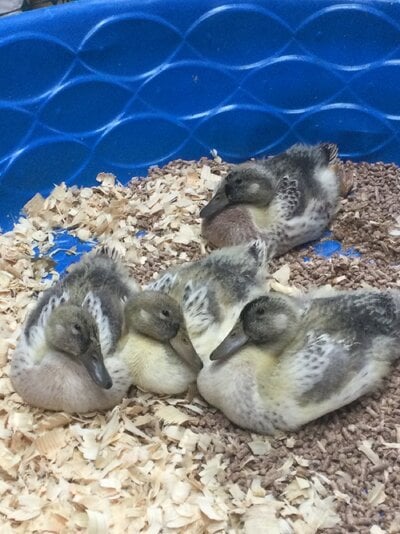This is another duck sexing thread, lol! Below are 4 ducklings I hatched out on April 1st/2nd from eggs off of eBay so they’re just about 5 weeks old. The only one quacking pretty loudly right now is on the left in the group of 3. She’s a bit of a busy body too! The rest are pretty quiet and whistle. I notice all of their heads are turning black starting at the beak but I don’t know if it means anything or if it’s “correct.” Is there any relation between the juvenile feathers and the adult feathers? I ask because the two on the right have pale chests so I’m wondering if they might be females. I know the drakes have darker chests so I’m just guessing the one in the back is male but I could be totally wrong.
Navigation
Install the app
How to install the app on iOS
Follow along with the video below to see how to install our site as a web app on your home screen.
Note: This feature may not be available in some browsers.
More options
You are using an out of date browser. It may not display this or other websites correctly.
You should upgrade or use an alternative browser.
You should upgrade or use an alternative browser.
Juvenile feathers on Welsh Harlequins/sexing
- Thread starter HennyPenny44
- Start date
Pics
More options
Who Replied?they are so cute. I dont know if this helps but I read this :
Welsh Harlequins have a unique, natural sex-linked characteristic. As day olds, sex can be determined based on bill colour with over 90% accuracy. Young drakes will have darker bills while female with have lighter with a dark spot at the tip of the bill.
Did you perhaps
take any photos of them at one day old age?
Welsh Harlequins have a unique, natural sex-linked characteristic. As day olds, sex can be determined based on bill colour with over 90% accuracy. Young drakes will have darker bills while female with have lighter with a dark spot at the tip of the bill.
Did you perhaps
take any photos of them at one day old age?
- Thread starter
- #3
Thank you! I don’t have any good photos of their bill color but I had one with a pink beak and dark tip, one seemed kind of in between and two were dark. I heard that this isn’t always a reliable method though based on lines so of course, I’m hoping that it’s unreliable in my favor!they are so cute. I dont know if this helps but I read this :
Welsh Harlequins have a unique, natural sex-linked characteristic. As day olds, sex can be determined based on bill colour with over 90% accuracy. Young drakes will have darker bills while female with have lighter with a dark spot at the tip of the bill.
Did you perhaps
take any photos of them at one day old age?
After purchasing a black sex link ”pullet” that feathered out as a male would but turned out to be a female, I try to go by more than one method to sex my birds.
behavior can give a hint too. I had 2 mallard duckings and 2 blue runners together , and one of the mallards (who turned out to be drake) kept chasing and nipping at all 3 others throughout their entire ducklinghood. . But whenever I held him he was a very calm snugglebug. the girls all hated to be held. He also had bigger feet, lol
to me it looks like you have 2 drakes there. only time will tell..
to me it looks like you have 2 drakes there. only time will tell..
If I remember correctly my male WH heads were darker than the girls at a fairly young age. I could tell mine by bill color when they arrived (2 days) but it didn't take long for the bills to go through color changes.
- Thread starter
- #6
Hmm, I will keep an eye out for nipping although it’s hard to tell who is doing what when they all look so similar. None of them like to be held it seems but they tolerate it. Yes, time will tell I guess!behavior can give a hint too. I had 2 mallard duckings and 2 blue runners together , and one of the mallards (who turned out to be drake) kept chasing and nipping at all 3 others throughout their entire ducklinghood. . But whenever I held him he was a very calm snugglebug. the girls all hated to be held. He also had bigger feet, lol
to me it looks like you have 2 drakes there. only time will tell..
- Thread starter
- #7
I will look out for the dark heads! Yes, I have no clue which one had which color beak as I didn’t band them.If I remember correctly my male WH heads were darker than the girls at a fairly young age. I could tell mine by bill color when they arrived (2 days) but it didn't take long for the bills to go through color changes.
The girls will quack, and the boys are softer weep weeps.
Similar threads
New posts New threads Active threads
-
Latest threads
-
-
-
Feather picking, depluming mites, something else…?
- Started by Jen26
- Replies: 3
-
-
Cannibalism extreme problem
- Started by OK chicken farmer
- Replies: 3
-
-
Threads with more replies in the last 15 days
-
-
-
-
Please Help! Eggbound & Possible Prolapsed Vent
- Started by Elspeth Dinsmore
- Replies: 99
-
2 week old chick labored breathing, gasping, lethargy
- Started by RandomAnarchy
- Replies: 89
-




